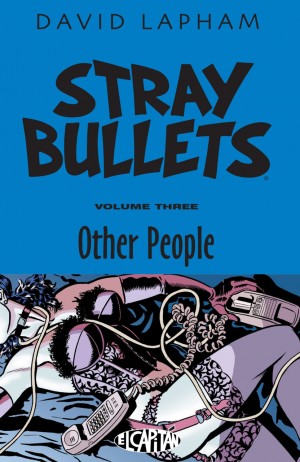Review by Ian Keogh
This fifth collection of the original Stray Bullets series is a value for money eleven episodes, or just over a quarter of the series to that point in a single book.
Three months have passed since the horrific events that comprised Dark Days. Amy is now Virginia Applejack again, returned to her mother’s care in Baltimore two years after she ran away. With what she’s seen, the assorted high school thugs hold little fear for her, and seemingly more to amuse herself than anything else, she concocts plans to set them at each other’s throats. This proves to be a more dangerous game that she anticipated, and although it takes a while, the darkness that’s infused Stray Bullets from the start eventually manifests.
David Lapham concocts his cast so well. On the face of things the group of football players he concentrates on are the standard campus jocks. You know the types, combine their brain cells and you’d still be short of a banana, but because they’re big and violent they rule the roost. Among them, however, is someone who’s a lot more complicated and who has considerable issues. Another is a grown version of someone who presented a threat in the opening Innocence of Nihilsm. As ever, each individual chapter is excellent, but when they’re combined there’s a sense of some marking time, as the pace isn’t as a frenetic as usual, which hasn’t been the case in any previous Stray Bullets collection. When read together, however, there’s also the revelation of how good Lapham has been in uniting his characters. The second story introduces the jocks encouraging one of their younger brothers to insult random passers by from a car. He eventually picks on the wrong person, and from there a major part of the story develops, although we don’t discover this until the final chapter.
Despite Hi-Jinks and Derring-Do’s containing more episodes than usual, there’s still only the single Amy Racecar story. This time she’s concocted a pastiche of comics set in feudal Japan, and Japanese action movies. As ever, there’s a reflection of the real world events Ginny’s experiencing, but it’s the funniest of a good selection over the series.
In terms of art it’s noticeable that there was a nine year gap separating the final two chapters when serialised, as there’s a looseness about the final chapter that contrasts the remainder, and the storytelling of Gilbert Hernandez appears to have become more of an influence. During that break in publication Lapham contributed a short story to the Noir anthology. It’s a different version of how events of the final chapter played out, and equally entertaining. It is, however, missing from the massive Stray Bullets Uber Alles Edition collecting the entire core series. After a gap of nine years Lapham would return to Stray Bullets with Killers.





